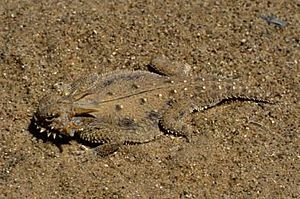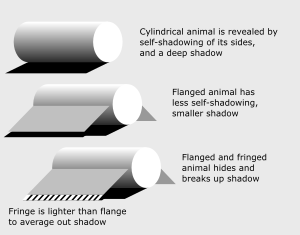Flat-tail horned lizard facts for kids
Quick facts for kids Flat-tail horned lizard |
|
|---|---|
 |
|
| Conservation status | |
| Scientific classification | |
| Genus: |
Phrynosoma
|
| Species: |
mcallii
|
The flat-tail horned lizard (Phrynosoma mcallii) is a special type of lizard. It belongs to the family called Phrynosomatidae.
This reptile lives only in the Sonoran Desert in the southwestern United States and northwestern Mexico. It has amazing adaptations that help it hide. One of its best tricks is making its shadow almost disappear!
Sadly, this lizard is facing threats. Its home is getting smaller because of human activities like farming and building. Because of this, it is a specially protected animal in the United States.
Contents
About the Flat-Tail Horned Lizard
This lizard got its name from a United States Army Colonel named George A. McCall. He found the very first one in California a long time ago in the 1800s.
The flat-tail horned lizard lives in a small area of the Sonoran Desert. You can find it in southeastern California, southwestern Arizona, and the very northern parts of Mexico. This includes the Baja California and Sonora states.
Over many years, different groups of these lizards have changed. They have adapted to the weather, food, and predators in their specific areas. This means they can look a bit different from each other.
Here's what a flat-tail horned lizard looks like:
- It's a medium-sized lizard with a flat, wide body.
- Its body is shaped like an oval.
- It has pointy scales scattered on its back and tail.
- The skin on its back is smooth, but it has small spines.
- There are 8 horns sticking out from the back of its head.
- The two horns in the middle are long, thin, and sharp.
- It has long, narrow spines on its lower jaw.
- There are two rows of fringe-like scales along its sides. The bottom row of scales is smaller than the top row.
How it Hides: Camouflage Tricks
The flat-tail horned lizard has developed amazing ways to hide itself. It works hard to make its shadow disappear.
Its body is very flat, and its sides get thinner towards the edges. The lizard often presses its body flat against the ground. Its sides also have white, fringe-like scales. These scales do a great job of hiding and breaking up any shadow that might be under its body.
Different groups of these lizards can change their colors to match their local surroundings. They do this using special cells in their back scales.
- Some cells are black and are called melanophores.
- Others are red and are called chromatophores.
- These are spread over a layer of white, shiny cells called iridophores.
This mix of cells allows the flat-tail horned lizard to match the color of the local soil or rocks. For example, lizards from the Algondones Dunes in Sonora are usually redder. This is because the sand there is redder. Lizards from the whiter Thousand Palms dunes in California are lighter. Also, a dark line down the middle of its back helps to break up the lizard's shape. It looks like the thin shadows of plant stems in its sandy, windy home.
Predators
The flat-tail horned lizard is a prey animal for a host of desert predators.
- Birds of prey like red-tailed hawks, American kestrels, loggerhead shrikes, and roadrunners.
- Snakes: Sidewinders, coachwhips, kingsnakes, and other desert-dwelling serpents.
- Mammals:Coyotes, kit foxes, bobcats, and even domestic dogs and cats.
Young flat-tail horned lizards are much more vulnerable and have a different set of predators. Their eggs, buried in sandy soil, are vulnerable to being dug up by foxes, coyotes, skunks, and a variety of reptiles and invertebrates. Tiny hatchlings are prey for a wider range of animals, including:
- Larger lizards (such as desert iguanas or even other horned lizards).
- Centipedes, tarantulas, and scorpions.
- Ants (which can overwhelm a newly hatched lizard).
- Snakes (even smaller species that wouldn't target an adult).
- Birds (like shrikes and thrashers).
A Species in Danger
The flat-tail horned lizard is facing threats. Its small home is being affected by new buildings, farms, and other human activities. Most of its remaining habitat in the U.S. is managed by the Bureau of Land Management.
These lizards often live in areas where natural gas, oil, and minerals can be found. In 1982, the U.S. Fish and Wildlife Service listed P. mcallii as a "Candidate 2 Category" species. This meant they were worried about threats to its habitat. They feared these threats could make the lizard's population even smaller.
P. mcallii also has special protection in both California and Arizona. This means people are not allowed to collect them.
Scientists have studied how the number of flat-tailed horned lizards changes. They looked at populations in the Coachella Valley, California. This lizard has the smallest range of any horned lizard in the United States. In some parts of its home, there are many activities happening at once. These include new neighborhoods, farming, off-road vehicle fun, and activities near the international border.
Between 1978 and 1980, the Bureau of Land Management supported studies in California. The goal was to find out where P. mcallii lived and how many there were. They also wanted to see how these numbers related to different parts of their habitat. Plus, they gathered information on how the lizard groups were structured. They also studied how much individual lizards moved and what they ate.
The study also looked at where the flat-tailed horned lizard lived and how many there were in Arizona. They found the lizard only in a desert area about 650–700 square kilometers in size. This area is in the southwestern corner of the state. The lizards were most common in places with:
- The Western whiptail (Cnemidophorus tigris) lizard.
- Nests of the black harvester ant (Messor pergandei).
- Galleta grass (Hilaria rigida).
- Sandy soils.



